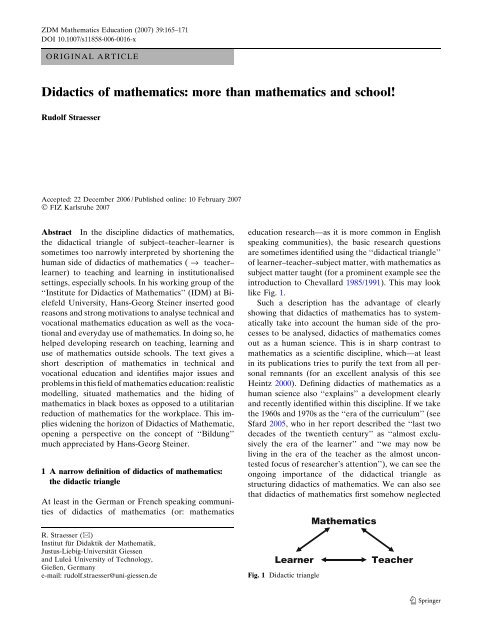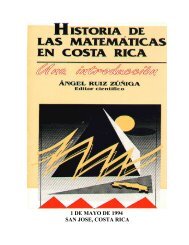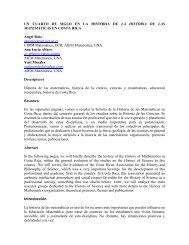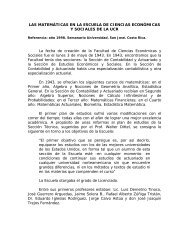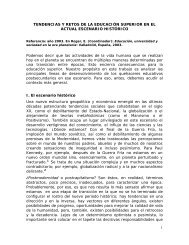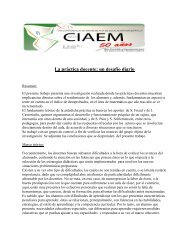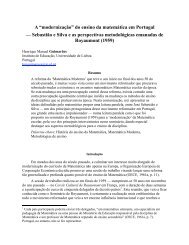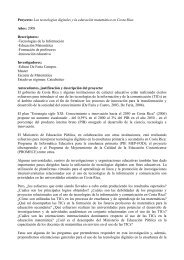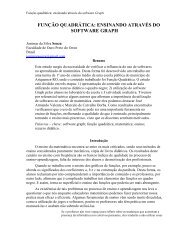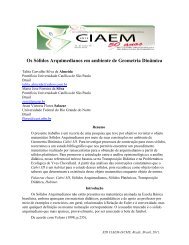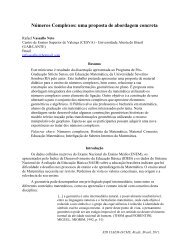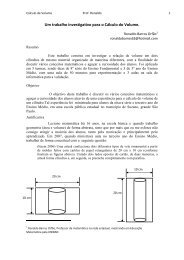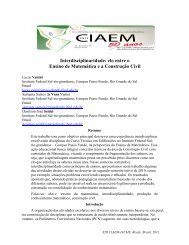Didactics of mathematics: more than mathematics and school! - CIMM
Didactics of mathematics: more than mathematics and school! - CIMM
Didactics of mathematics: more than mathematics and school! - CIMM
Create successful ePaper yourself
Turn your PDF publications into a flip-book with our unique Google optimized e-Paper software.
ZDM Mathematics Education (2007) 39:165–171<br />
DOI 10.1007/s11858-006-0016-x<br />
ORIGINAL ARTICLE<br />
<strong>Didactics</strong> <strong>of</strong> <strong>mathematics</strong>: <strong>more</strong> <strong>than</strong> <strong>mathematics</strong> <strong>and</strong> <strong>school</strong>!<br />
Rudolf Straesser<br />
Accepted: 22 December 2006 / Published online: 10 February 2007<br />
Ó FIZ Karlsruhe 2007<br />
Abstract In the discipline didactics <strong>of</strong> <strong>mathematics</strong>,<br />
the didactical triangle <strong>of</strong> subject–teacher–learner is<br />
sometimes too narrowly interpreted by shortening the<br />
human side <strong>of</strong> didactics <strong>of</strong> <strong>mathematics</strong> ( fi teacher–<br />
learner) to teaching <strong>and</strong> learning in institutionalised<br />
settings, especially <strong>school</strong>s. In his working group <strong>of</strong> the<br />
‘‘Institute for <strong>Didactics</strong> <strong>of</strong> Mathematics’’ (IDM) at Bielefeld<br />
University, Hans-Georg Steiner inserted good<br />
reasons <strong>and</strong> strong motivations to analyse technical <strong>and</strong><br />
vocational <strong>mathematics</strong> education as well as the vocational<br />
<strong>and</strong> everyday use <strong>of</strong> <strong>mathematics</strong>. In doing so, he<br />
helped developing research on teaching, learning <strong>and</strong><br />
use <strong>of</strong> <strong>mathematics</strong> outside <strong>school</strong>s. The text gives a<br />
short description <strong>of</strong> <strong>mathematics</strong> in technical <strong>and</strong><br />
vocational education <strong>and</strong> identifies major issues <strong>and</strong><br />
problems in this field <strong>of</strong> <strong>mathematics</strong> education: realistic<br />
modelling, situated <strong>mathematics</strong> <strong>and</strong> the hiding <strong>of</strong><br />
<strong>mathematics</strong> in black boxes as opposed to a utilitarian<br />
reduction <strong>of</strong> <strong>mathematics</strong> for the workplace. This implies<br />
widening the horizon <strong>of</strong> <strong>Didactics</strong> <strong>of</strong> Mathematic,<br />
opening a perspective on the concept <strong>of</strong> ‘‘Bildung’’<br />
much appreciated by Hans-Georg Steiner.<br />
1 A narrow definition <strong>of</strong> didactics <strong>of</strong> <strong>mathematics</strong>:<br />
the didactic triangle<br />
At least in the German or French speaking communities<br />
<strong>of</strong> didactics <strong>of</strong> <strong>mathematics</strong> (or: <strong>mathematics</strong><br />
education research—as it is <strong>more</strong> common in English<br />
speaking communities), the basic research questions<br />
are sometimes identified using the ‘‘didactical triangle’’<br />
<strong>of</strong> learner–teacher–subject matter, with <strong>mathematics</strong> as<br />
subject matter taught (for a prominent example see the<br />
introduction to Chevallard 1985/1991). This may look<br />
like Fig. 1.<br />
Such a description has the advantage <strong>of</strong> clearly<br />
showing that didactics <strong>of</strong> <strong>mathematics</strong> has to systematically<br />
take into account the human side <strong>of</strong> the processes<br />
to be analysed, didactics <strong>of</strong> <strong>mathematics</strong> comes<br />
out as a human science. This is in sharp contrast to<br />
<strong>mathematics</strong> as a scientific discipline, which—at least<br />
in its publications tries to purify the text from all personal<br />
remnants (for an excellent analysis <strong>of</strong> this see<br />
Heintz 2000). Defining didactics <strong>of</strong> <strong>mathematics</strong> as a<br />
human science also ‘‘explains’’ a development clearly<br />
<strong>and</strong> recently identified within this discipline. If we take<br />
the 1960s <strong>and</strong> 1970s as the ‘‘era <strong>of</strong> the curriculum’’ (see<br />
Sfard 2005, who in her report described the ‘‘last two<br />
decades <strong>of</strong> the twentieth century’’ as ‘‘almost exclusively<br />
the era <strong>of</strong> the learner’’ <strong>and</strong> ‘‘we may now be<br />
living in the era <strong>of</strong> the teacher as the almost uncontested<br />
focus <strong>of</strong> researcher’s attention’’), we can see the<br />
ongoing importance <strong>of</strong> the didactical triangle as<br />
structuring didactics <strong>of</strong> <strong>mathematics</strong>. We can also see<br />
that didactics <strong>of</strong> <strong>mathematics</strong> first somehow neglected<br />
R. Straesser (&)<br />
Institut für Didaktik der Mathematik,<br />
Justus-Liebig-Universität Giessen<br />
<strong>and</strong> Luleå University <strong>of</strong> Technology,<br />
Gießen, Germany<br />
e-mail: rudolf.straesser@uni-giessen.de<br />
Fig. 1 Didactic triangle<br />
123
166 R. Straesser<br />
the human parts <strong>of</strong> its discipline by concentrating on<br />
the subject matter side via the focus on the curriculum.<br />
The focus on subject matter, the focus on <strong>mathematics</strong><br />
had different faces in different countries. In France for<br />
instance, the IREM movement clearly defined itself as<br />
coming from an epistemological fundament. Some<br />
French colleagues even suggested to define the<br />
fundamental ‘‘Didactique des Mathématiques’’ as<br />
‘‘experimental epistemology’’ (according to Brousseau<br />
(1986, p. 103): ‘‘épistémologie expérimentale’’). For<br />
Germany, we can exemplify the focus on subject matter<br />
with the then widely accepted definition ‘‘didactics<br />
<strong>of</strong> <strong>mathematics</strong> is the scientific development <strong>of</strong> courses<br />
to be effectively used to learn in the area <strong>of</strong> <strong>mathematics</strong>.<br />
It is also made up <strong>of</strong> the practical teaching <strong>of</strong><br />
such courses <strong>and</strong> their empirical evaluation. This includes<br />
reflections on the aims <strong>and</strong> subject matter<br />
selection <strong>of</strong> such courses’’ (‘‘Didaktik der Mathematik<br />
ist die Wissenschaft von der Entwicklung praktikabler<br />
Kurse für das Lernen im Bereich Mathematik sowie<br />
der praktischen Durchführung und empirischen<br />
Überprüfung der Kurse einschliesslich der Überlegungen<br />
zur Zielsetzung der Kurse und der St<strong>of</strong>fauswahl’’,<br />
see Griesel (1971, p. 296), nearly identical in<br />
Griesel (1974); a <strong>more</strong> recent, internationally read text<br />
is Wittmann (1992, English version 1995). In the<br />
beginning <strong>of</strong> the 1970s, Hans-Georg Steiner also took<br />
didactics <strong>of</strong> <strong>mathematics</strong> as fundamentally defined by<br />
the knowledge to be taught, by <strong>mathematics</strong>—as can<br />
be seen from his publication on ‘‘Bildung’’ (see Steiner<br />
1972). He described didactics <strong>of</strong> <strong>mathematics</strong> as<br />
‘‘thinking through <strong>mathematics</strong> under the perspective<br />
<strong>of</strong> the elementary <strong>and</strong> the motivation for the learner’’<br />
(loc. cit., free translation from p. 326; ‘‘Das Durchdenken<br />
des Gebäudes der Mathematik unter dem<br />
Gesichtspunkt des Elementaren und im Hinblick auf<br />
die Motivation des Lernenden gibt dieser Wissenschaft<br />
ein lebensnahes Fundament ...’’). Until around the end<br />
<strong>of</strong> the 1970s, the so-called St<strong>of</strong>fdidaktik was the predominant<br />
approach to didactics <strong>of</strong> <strong>mathematics</strong> in<br />
Germany, sometimes even reducing didactics <strong>of</strong><br />
<strong>mathematics</strong> to a mere ‘‘elementarisation’’ <strong>of</strong> <strong>mathematics</strong><br />
for the purpose <strong>of</strong> its teaching.<br />
At the end <strong>of</strong> the 1970s, Steiner had a broader definition<br />
<strong>of</strong> didactics <strong>of</strong> <strong>mathematics</strong>. He stated that the<br />
constraints <strong>and</strong> factors, which determine the classroom<br />
<strong>of</strong> <strong>mathematics</strong> <strong>and</strong> its changeability, belong to didactics<br />
<strong>of</strong> <strong>mathematics</strong>. This includes the complex processes <strong>of</strong><br />
social interaction related to the teaching <strong>and</strong> learning <strong>of</strong><br />
content matter <strong>and</strong> ways <strong>of</strong> behaviour (free translation<br />
by RS <strong>of</strong> ‘‘Mathematikdidaktik wird dabei in einem<br />
erweiterten Sinne verst<strong>and</strong>en -als vorwiegend materialorientierte<br />
Entwicklungsarbeit, Einfügung RS, wonach<br />
sowohl die den mathematischen Unterricht und<br />
seine Veränderbarkeit bestimmenden Bedingungen<br />
und Faktoren als auch die komplexen sozialen Interaktionsprozesse<br />
im Unterricht in ihrem Zusammenhang<br />
mit der Vermittlung und dem Erwerb von Inhalten und<br />
Verhaltensweisen wesentliche Best<strong>and</strong>teile bzw. Dimensionen<br />
der Untersuchungsgegenstände sind’’; see<br />
Steiner 1978, p. XL). Obviously, <strong>and</strong> probably in relation<br />
with the creation <strong>of</strong> the national research institute<br />
for didactics <strong>of</strong> <strong>mathematics</strong> (Institut für Didaktik der<br />
Mathematik—IDM) in Bielefeld, Steiner looked further<br />
<strong>than</strong> the curriculum <strong>and</strong> course developers abundant<br />
at that time—at least in Germany. Nevertheless,<br />
this perspective was still concentrating on the process <strong>of</strong><br />
teaching <strong>and</strong> learning in <strong>school</strong>s, institutions to <strong>of</strong>fer (an<br />
underst<strong>and</strong>ing <strong>of</strong>) <strong>mathematics</strong> to everybody.<br />
2 An opening: <strong>mathematics</strong> in technical<br />
<strong>and</strong> vocational education<br />
About 10 years later <strong>and</strong> in France, we find a slightly<br />
broader definition: didactics <strong>of</strong> <strong>mathematics</strong> (is) the<br />
science <strong>of</strong> the specific conditions <strong>of</strong> the diffusion <strong>of</strong><br />
mathematical knowledge useful for the functioning <strong>of</strong><br />
the human institutions (‘‘La didactique des mathématiques<br />
se place ... dans le cadre des sciences cognitives<br />
comme la science des conditions spécifiques de la diffusion<br />
des connaissances mathématiques utiles au<br />
fonctionnement des institutions humaines’’, see<br />
Brousseau 1994, p. 52). Here, didactics <strong>of</strong> <strong>mathematics</strong><br />
has left the narrow area <strong>of</strong> <strong>school</strong>s <strong>and</strong> looks into the<br />
diffusion <strong>of</strong> <strong>mathematics</strong> in society at large.<br />
Even if nearly invisible in his list <strong>of</strong> publications,<br />
Steiner too had crossed this borderline <strong>of</strong> <strong>school</strong>s in his<br />
activities: Because <strong>of</strong> his interest in the pedagogical<br />
concept <strong>of</strong> ‘‘Bildung’’ (see the text entitled ‘‘Mathematik<br />
und Bildung’’; Steiner 1972) <strong>and</strong> an ongoing<br />
German debate on a reform <strong>of</strong> upper secondary<br />
teaching in general, Steiner had taken the job <strong>of</strong> a<br />
scientific counsellor <strong>of</strong> a major German reform project—the<br />
‘‘Kollegstufe’’ piloted by Herwig Blankertz.<br />
Kollegstufe aimed at <strong>of</strong>fering upper secondary education<br />
for virtually everybody in need <strong>of</strong> this—from the<br />
future unskilled worker to the young adult planning an<br />
academic career. This reform project especially fitted<br />
with the intentions <strong>of</strong> the Bielefeld institute IDM <strong>and</strong><br />
Hans-Georg Steiner, because Blankertz wanted to<br />
build his project on the joint efforts <strong>of</strong> the different<br />
subject matter didactics (‘‘Fachdidaktiken’’) available<br />
at that time. Steiner integrated a <strong>mathematics</strong> teacher<br />
from the ‘‘Kollegstufe’’-project in his working group<br />
in Bielefeld after having made upper secondary<br />
123
<strong>Didactics</strong> <strong>of</strong> <strong>mathematics</strong>: <strong>more</strong> <strong>than</strong> <strong>mathematics</strong> <strong>and</strong> <strong>school</strong>! 167<br />
<strong>mathematics</strong> teaching <strong>and</strong> learning the field <strong>of</strong> research<br />
<strong>of</strong> his working group in the mid 1970s. With a first<br />
academic training as a <strong>mathematics</strong> teacher for Gymnasium,<br />
Steiner at that time broadened his interests to<br />
all types <strong>of</strong> education <strong>and</strong> training at the upper secondary<br />
level. As a consequence <strong>and</strong> in the German<br />
organisation <strong>of</strong> the educational system, this implied<br />
that <strong>mathematics</strong> also in technical <strong>and</strong> vocational<br />
education had to be studied in his working group. In<br />
addition to this <strong>and</strong> with the apprenticeship system as a<br />
major part <strong>of</strong> technical <strong>and</strong> vocational education <strong>and</strong><br />
training, the German upper secondary educational<br />
system <strong>of</strong>fered an opportunity not to study only classroom<br />
environments, but also look into <strong>mathematics</strong> in<br />
commercial <strong>and</strong> industrial settings.<br />
2.1 Vocational <strong>mathematics</strong>: a description<br />
Contrary to the practice <strong>of</strong> defining <strong>mathematics</strong> education<br />
at upper secondary by <strong>mathematics</strong> to prepare<br />
for university studies, looking into <strong>mathematics</strong> in<br />
technical <strong>and</strong> vocational education implies a different<br />
approach. The book edited by Bessot <strong>and</strong> Ridgeway<br />
(2000) gives an excellent overview <strong>of</strong> research into this<br />
field, showing that—apart from university bound<br />
young adults—one has to also care for the vast<br />
majority <strong>of</strong> adolescents who <strong>more</strong> or less directly go<br />
into the labour market <strong>and</strong> everyday life. In most,<br />
especially industrialised countries, some sort <strong>of</strong> mathematical<br />
knowledge is part <strong>of</strong> the vocational training—if<br />
there is an institutionalised training for<br />
vocations at all.<br />
Once upon a time, UNESCO described this training<br />
<strong>and</strong>/or education as ‘‘the educational process ...<br />
(which) involves, in addition to general education, the<br />
study <strong>of</strong> technologies <strong>and</strong> related sciences <strong>and</strong> the<br />
acquisition <strong>of</strong> practical skills <strong>and</strong> knowledge relating<br />
occupations in various sectors <strong>of</strong> economic <strong>and</strong> social<br />
life’’ (UNESCO 1978, p. 17). Even if it is methodologically<br />
rather difficult to describe the mathematical<br />
needs <strong>of</strong> the workplace, the common core <strong>of</strong> this part<br />
<strong>of</strong> <strong>mathematics</strong> was <strong>of</strong>ten described as ‘‘basic arithmetic,<br />
percentages <strong>and</strong> proportion, ... for some vocations,<br />
these techniques already seem to be all the<br />
<strong>mathematics</strong>’ topics needed’’ (cf. Straesser <strong>and</strong><br />
Zevenbergen 1996, p. 653). Apart from this, it seems to<br />
be very difficult to discern the ‘real’ pr<strong>of</strong>essional use <strong>of</strong><br />
<strong>mathematics</strong>. Straesser <strong>and</strong> Zevenbergen (loc. cit.) cite<br />
from the 1985-Cockcr<strong>of</strong>t-report: ‘‘It is therefore not<br />
possible to produce definitive lists <strong>of</strong> the mathematical<br />
topics <strong>of</strong> which a knowledge will be needed in order to<br />
carry out jobs with a particular title’’. Additional<br />
algebraic techniques seem to be in use in technical <strong>and</strong><br />
economical vocations, Geometry use seems to be restricted<br />
to the technical <strong>and</strong> building sector (loc. cit.).<br />
Little is known about the <strong>mathematics</strong> ‘‘needed’’ for<br />
the upper part <strong>of</strong> the qualification spectrum, even if<br />
‘‘<strong>mathematics</strong> as a service subject’’ is part <strong>of</strong> a lot <strong>of</strong><br />
academic training for future engineers <strong>and</strong> management<br />
personnel (see the pertinent ICMI-study no. 3 on<br />
this issue with Howson et al. 1988 as its proceedings).<br />
If one looks into the list <strong>of</strong> publications <strong>of</strong> Hans-<br />
Georg Steiner, studies into this broader field <strong>of</strong> upper<br />
secondary (<strong>mathematics</strong>) education are nearly invisible—with<br />
one major exception: Steiner <strong>and</strong> Straesser<br />
(1982). Here, the vast range <strong>of</strong> technical <strong>and</strong> vocational<br />
education is narrowed down to that part <strong>of</strong> the training<br />
<strong>and</strong> education <strong>of</strong> young adults who try a direct entry to<br />
the world <strong>of</strong> work after compulsory <strong>school</strong>ing. At least<br />
in Germany, this is still <strong>more</strong> <strong>than</strong> half <strong>of</strong> the population<br />
<strong>and</strong> has a special organization called ‘Lehrlingsausbildung’,<br />
internationally known as ‘apprenticeship’,<br />
i.e. joint efforts <strong>of</strong> vocational colleges <strong>and</strong> companies<br />
to train a skilled workforce. From this short description,<br />
a major tension may already be obvious: How to<br />
cope with the specific, but ‘‘needs’’ <strong>of</strong> a whole variety<br />
<strong>of</strong> different vocations from hairdressing to the building<br />
sector <strong>and</strong> business administration or electrical <strong>and</strong><br />
even computer based information technology? What<br />
about the mathematical ‘‘needs’’ <strong>of</strong> this diverse occupational<br />
fields <strong>and</strong> (in Germany: <strong>more</strong> <strong>than</strong> 400)<br />
vocations? What has didactics <strong>of</strong> <strong>mathematics</strong> to <strong>of</strong>fer<br />
to this training/education linking classrooms <strong>of</strong> vocational<br />
colleges to workplaces in the different occupational<br />
fields?<br />
2.2 Realistic modelling<br />
Looking into vocational <strong>mathematics</strong>—in the narrow<br />
sense <strong>of</strong> a direct move or preparation for workplaces—<strong>of</strong>fers<br />
a chance, which <strong>mathematics</strong> in compulsory<br />
<strong>school</strong>s <strong>of</strong>ten do not have: with the workplace <strong>and</strong><br />
vocation to be trained for clearly identified, there is an<br />
obvious field <strong>of</strong> application for <strong>mathematics</strong> in this<br />
type <strong>of</strong> training/education. To put it in a different<br />
wording: vocational <strong>mathematics</strong> in principle immediately<br />
<strong>of</strong>fers a field outside <strong>mathematics</strong>, to which<br />
<strong>mathematics</strong> can be applied, it does not have to look in<br />
the vague ‘‘rest <strong>of</strong> the world’’ <strong>of</strong>ten mentioned when<br />
applications <strong>of</strong> <strong>mathematics</strong> are discussed. If the<br />
vocational field ‘‘asks’’ for <strong>mathematics</strong> to be used<br />
(<strong>and</strong> this is not always obvious, see the next subsection),<br />
the vocational field <strong>of</strong>fers a vast array <strong>of</strong> applications<br />
for <strong>mathematics</strong>.<br />
If we take the example <strong>of</strong> technical vocations related<br />
to metalwork, Schilling (1984, p. 116; in a text for a<br />
123
168 R. Straesser<br />
developmental project piloted by Steiner <strong>and</strong> Straesser)<br />
stressed the importance <strong>of</strong> <strong>mathematics</strong> for this<br />
vocational area, but also pointed to the fact that<br />
<strong>mathematics</strong> is used as a ‘strategic’ tool to model the<br />
workplace situation, to fulfil the quantification needs <strong>of</strong><br />
the vocational situation in order to have easy predictions<br />
<strong>of</strong> the application <strong>of</strong> machines <strong>and</strong> procedures.<br />
Mathematics is not needed as such, it <strong>of</strong>fers a (very<br />
versatile) tool to model the workplace situation. Consequently,<br />
the vocational theory is not interested in a<br />
deep underst<strong>and</strong>ing <strong>of</strong> mathematical concepts or procedures,<br />
but in an effective <strong>and</strong> fast prediction <strong>of</strong> the<br />
vocational situation (loc. cit., p. 118).<br />
A comparable description can be found for the<br />
workplaces related to (traditional, not computer related)<br />
electricity: Rauner (1984, p. 151) denies <strong>mathematics</strong><br />
an independent role in the training <strong>of</strong> future<br />
qualified worker in electricity surroundings, but mentions<br />
the role <strong>of</strong> <strong>mathematics</strong> as a help to underst<strong>and</strong><br />
vocational situations—with trigonometric functions as<br />
the prototypic example helping to underst<strong>and</strong> alternating<br />
current. He even goes as far as saying that<br />
underst<strong>and</strong>ing electro technical devices is simply<br />
impossible without <strong>mathematics</strong>—but wants these<br />
mathematical models preferably presented in diagrams<br />
<strong>and</strong> graphs, not in numbers or equations (loc. cit., p.<br />
152f; for examples see the end <strong>of</strong> his paper).<br />
2.3 The utilitarian reduction<br />
Looking into <strong>mathematics</strong> in vocational training <strong>and</strong><br />
education is one efficient way to walk out <strong>of</strong> the<br />
classroom to study <strong>mathematics</strong> <strong>and</strong> its use out <strong>of</strong><br />
<strong>school</strong>. This nevertheless implies a temptation, which<br />
Hans-Georg Steiner always resisted, but should nevertheless<br />
be mentioned: Studying workplace use <strong>of</strong><br />
<strong>mathematics</strong> <strong>of</strong>ten tends to reduce the purpose <strong>of</strong><br />
<strong>mathematics</strong> to its importance for aims outside <strong>mathematics</strong>.<br />
Falling into this trap implies the idea, that<br />
teaching <strong>and</strong> learning <strong>of</strong> <strong>mathematics</strong> is (mainly, if not<br />
only) done for utilitarian reasons, for the sake <strong>of</strong> the<br />
role <strong>of</strong> <strong>mathematics</strong>’ in its applications. From the<br />
description <strong>of</strong> the developmental project mentioned<br />
above, one can see that Steiner (<strong>and</strong> his team) did not<br />
reduce vocational training to utilitarian purposes.<br />
Apart from three other problems <strong>of</strong> teaching <strong>mathematics</strong><br />
in this type <strong>of</strong> vocational training, the project<br />
wanted to take into account the tension between<br />
vocational <strong>and</strong> general education (in German: ‘‘beruflicher<br />
und allgemeiner Bildung’’, see Steiner <strong>and</strong><br />
Straesser 1982, p.16).<br />
The modelling approach <strong>of</strong> Sect. 2.2, especially the<br />
comments from the metalwork <strong>and</strong> electricity area,<br />
already show that a simplistic utilitarian approach to<br />
<strong>mathematics</strong> is inappropriate for vocational training—last<br />
not least because the sheer practice <strong>of</strong> the<br />
workplace is not interested in the workers underst<strong>and</strong>ing<br />
the processes <strong>of</strong> production <strong>and</strong> distribution,<br />
but will only look into a continuous functioning <strong>of</strong><br />
machines <strong>and</strong> the labour force. Research into <strong>mathematics</strong><br />
at the workplace has shown the limitations <strong>of</strong><br />
such an approach in <strong>more</strong> detail: as long as the production/distribution<br />
process goes uninterrupted by<br />
unexpected events, goes without (unforeseen) problems,<br />
underst<strong>and</strong>ing the process (maybe with the help<br />
<strong>of</strong> <strong>mathematics</strong>) is not necessary, sometimes even disturbing.<br />
The worker may even override the information<br />
produced by a mathematical model.<br />
A nice confirmation <strong>of</strong> this statement from the<br />
banking sector may be the comment <strong>of</strong> a person ‘‘in<br />
charge <strong>of</strong> support <strong>and</strong> maintenance <strong>of</strong> computer<br />
equipment’’ in an investment bank (see Noss <strong>and</strong><br />
Hoyles 1996, p. 7f). He commented his evaluation <strong>of</strong> a<br />
piece <strong>of</strong> equipment by using a pre-programmed<br />
spreadsheet by ‘‘I press the button <strong>and</strong> see what it says.<br />
.... I look at the answer. If it seems to indicate what I<br />
think we should do, I use the number to justify my<br />
decision. If not, I ignore it, or put in figures which will<br />
support my hunch.’’ It its all too obvious that <strong>mathematics</strong><br />
cannot be used as an unquestioned, simple<br />
model <strong>of</strong> the vocational situation.<br />
A quote from an experienced teacher trainer in the<br />
metalworking area shows a different limitation <strong>of</strong> a too<br />
simplistic utilitarian reduction <strong>of</strong> the use <strong>of</strong> <strong>mathematics</strong><br />
in vocational situations: ‘‘Mathematics in<br />
vocational education is serving <strong>more</strong> as a background<br />
knowledge for explaining <strong>and</strong> avoiding mistakes, recognising<br />
safety risks, judicious measurement <strong>and</strong> various<br />
forms <strong>of</strong> estimation. ... Not practice at the<br />
workplace but deepening <strong>of</strong> the pr<strong>of</strong>essional knowledge,<br />
education to a responsible use <strong>of</strong> tools <strong>and</strong> machines<br />
<strong>and</strong> the underst<strong>and</strong>ing <strong>of</strong> <strong>and</strong> coping with<br />
everyday mathematical problems legitimise <strong>mathematics</strong><br />
in vocational education’’ (quoted from Appelrath<br />
1985, pp. 133–139; translation R.S.). In the<br />
statement from metalwork, <strong>mathematics</strong> takes a specific<br />
role to further an underst<strong>and</strong>ing <strong>of</strong> the workplace<br />
situation. It is not directly operative in the situation on<br />
the shop floor.<br />
2.4 Black boxes<br />
As a consequence, <strong>mathematics</strong> is far from obvious in<br />
vocational situations—somehow confirming the difficulties<br />
to identify vocational <strong>mathematics</strong> already<br />
mentioned in Sect. 2.1. Difficulties to find <strong>mathematics</strong><br />
123
<strong>Didactics</strong> <strong>of</strong> <strong>mathematics</strong>: <strong>more</strong> <strong>than</strong> <strong>mathematics</strong> <strong>and</strong> <strong>school</strong>! 169<br />
in the workplace seem to even grow with the increasing<br />
use <strong>of</strong> (modern) technology. Some people even speak<br />
<strong>of</strong> the ,,disappearance <strong>of</strong> <strong>mathematics</strong> from society’s<br />
perception’’ (title <strong>of</strong> Straesser 2002). The use <strong>of</strong><br />
<strong>mathematics</strong> (in a simple utilitarian sense) as backbone<br />
<strong>of</strong> models <strong>of</strong> a vocational situation is <strong>of</strong>ten implemented<br />
in graphs <strong>and</strong> algorithms, maybe even machines,<br />
hides the inherent mathematical procedures<br />
<strong>and</strong> concepts from the direct perception <strong>of</strong> the user.<br />
S/he may see the situation as not containing any<br />
<strong>mathematics</strong>, because the <strong>mathematics</strong> parts is ‘‘crystallised’’<br />
in artefacts like graphs, tables or machines<br />
like automatic wages, control devices <strong>and</strong> protocols.<br />
The user might only be confronted with some pointer,<br />
which has to be kept within a given interval (in a<br />
steering/control situation) or answered by a certain<br />
activity (for instance in a buying situation with the<br />
price automatically given by a digital balance; for details<br />
<strong>of</strong> the development <strong>of</strong> weighing, see Straesser<br />
2002). The highly integrated automatic control systems<br />
<strong>of</strong> the flow <strong>of</strong> cash <strong>and</strong> goods are another illustration <strong>of</strong><br />
this tendency to hide <strong>mathematics</strong> from being noticed.<br />
The whole development can be described as the<br />
gradual, but steady introduction <strong>of</strong> ‘‘black boxes’’ into<br />
the production <strong>and</strong> distribution <strong>of</strong> goods <strong>and</strong> services<br />
in a modern economy.<br />
Consequences for the teaching <strong>and</strong> learning <strong>of</strong><br />
<strong>mathematics</strong> are far from obvious. In accordance with<br />
the proclaimed habit <strong>of</strong> mathematicians to always go<br />
back to the source <strong>of</strong> knowledge <strong>and</strong> leave no statement<br />
unproved, some educators explicitly opt for an<br />
opening <strong>of</strong> these boxes, which should go as far as<br />
possible—even avoiding the use <strong>of</strong> such algorithms <strong>and</strong><br />
automatisms as long as they have not been explained<br />
<strong>and</strong> understood (for an example see Buchberger 1989).<br />
In sharp contrast, Peschek for instance clearly stated<br />
the impossibility <strong>of</strong> such a procedure, advocating an<br />
intelligent <strong>and</strong> efficient use <strong>of</strong> black boxes (see Peschek<br />
1999, p. 270).<br />
Straesser (2002) even goes further in pointing to the<br />
fact that the role <strong>of</strong> technology in itself can be quite<br />
ambivalent. On the one h<strong>and</strong>, (modern computer)<br />
technology may be a very effective way to hide the use<br />
<strong>of</strong> <strong>mathematics</strong> from societal perception. ‘‘On the<br />
other h<strong>and</strong>, ... the same technology can be used to<br />
demystify the black boxes, to show the mathematical<br />
relations <strong>and</strong> <strong>of</strong>fer an opportunity to explore the<br />
inherent, implemented relations in a way workplace<br />
reality would never allow because <strong>of</strong> the risk <strong>of</strong><br />
material, financial <strong>and</strong> time losses. The practice <strong>of</strong><br />
using sophisticated <strong>mathematics</strong> can be brought to the<br />
foreground <strong>and</strong> hence to the consciousness <strong>of</strong> the user<br />
by appropriate s<strong>of</strong>tware <strong>and</strong> vocational training/education.<br />
It is modern computer technology <strong>and</strong> appropriate<br />
s<strong>of</strong>tware which can be successfully used to really<br />
explore <strong>and</strong> underst<strong>and</strong> the underlying ... <strong>mathematics</strong>’’<br />
(Straesser 2002, p. 130).<br />
2.5 Situated <strong>mathematics</strong><br />
What was reported about <strong>mathematics</strong> at the workplace<br />
<strong>and</strong> vocational training/education related to this<br />
all starts from a common, normally not contested<br />
assumption: <strong>mathematics</strong> is a special type <strong>of</strong> knowledge<br />
with a specific structure, special ways <strong>of</strong> proving<br />
<strong>and</strong> a clear borderline to separate <strong>mathematics</strong> from<br />
the ‘rest <strong>of</strong> the world’ (as Pollak described it at ICME<br />
3, see Pollak 1979). A modelling approach to applications<br />
<strong>of</strong> <strong>mathematics</strong> as well as the idea <strong>of</strong> black boxes<br />
hiding <strong>mathematics</strong> heavily rely on this separation <strong>of</strong><br />
<strong>mathematics</strong> from the rest <strong>of</strong> the world.<br />
Workplace <strong>mathematics</strong> somehow questions this<br />
idea—last not least because the difficulties <strong>of</strong> identifying<br />
<strong>mathematics</strong> used in the workplace. Inspired by<br />
research into the use <strong>of</strong> mathematical ideas in workplace<br />
situations like banking, nursing, piloting an airplane<br />
<strong>and</strong> engineering, Hoyles <strong>and</strong> Noss (2004)<br />
detailed the concept <strong>of</strong> ‘situated abstractions’ in<br />
<strong>mathematics</strong> they had already brought forward earlier.<br />
• ‘‘mathematical meanings that emerge through webbing<br />
with tools that ‘embed’ <strong>mathematics</strong><br />
• in use or communication display ‘correct’ mathematical<br />
invariants<br />
• are expressed with the language <strong>of</strong> the tools <strong>and</strong><br />
community<br />
• are abstracted within, not away from (the workplace,<br />
insert RS) community’’.<br />
It is obvious that these situated abstractions related<br />
to <strong>mathematics</strong> are no longer part <strong>of</strong> <strong>mathematics</strong> or<br />
‘the rest <strong>of</strong> the world’ alone, but are a new type <strong>of</strong><br />
knowledge bridging the divide between <strong>mathematics</strong><br />
<strong>and</strong> the rest <strong>of</strong> the world.<br />
To make this idea functional for teaching <strong>and</strong><br />
learning, Hoyles added the concept <strong>of</strong> ‘techno-mathematical<br />
literacies’ (see Hoyles <strong>and</strong> Noss 2004). Even if<br />
these concepts are developed from research into<br />
<strong>mathematics</strong> in the workplace, these concepts can<br />
obviously be used in a <strong>more</strong> general sense, in the<br />
general scientific debate about teaching <strong>and</strong> learning<br />
<strong>mathematics</strong>—not isolating workplace <strong>mathematics</strong><br />
from the vast majority <strong>of</strong> a didactics <strong>of</strong> <strong>mathematics</strong><br />
research community not necessarily interested in<br />
workplace <strong>mathematics</strong>.<br />
123
170 R. Straesser<br />
3 Utilitarian <strong>mathematics</strong> <strong>and</strong> ‘‘Bildung’’<br />
In Sect. 2, the consequences <strong>of</strong> looking into vocational<br />
<strong>mathematics</strong> education <strong>and</strong> some results <strong>of</strong> research<br />
into this type <strong>of</strong> teaching <strong>and</strong> learning <strong>and</strong> on research<br />
into <strong>mathematics</strong> at the workplace have been described.<br />
One could see how this field <strong>of</strong> research throws<br />
a new light onto the human struggle with <strong>mathematics</strong>,<br />
how this breaking out <strong>of</strong> the narrow confines <strong>of</strong> the<br />
institution classroom/<strong>school</strong> can add to didactics <strong>of</strong><br />
<strong>mathematics</strong>. Looking into <strong>mathematics</strong> in the workplace<br />
<strong>and</strong> in vocational education obviously has<br />
something to <strong>of</strong>fer to didactics <strong>of</strong> <strong>mathematics</strong> as a<br />
scientific discipline. One could also see that current<br />
research in this field is still mainly concerned with the<br />
subject matter <strong>mathematics</strong> <strong>and</strong> its role in the workplace<br />
<strong>and</strong> vocational education. The role <strong>and</strong> problems<br />
<strong>of</strong> the human learner are still somehow neglected in<br />
<strong>mathematics</strong> in vocational education.<br />
The typical German concept <strong>of</strong> ‘‘Bildung’’ may be<br />
an appropriate way to overcome this limitation. Even if<br />
the German word cannot be easily translated into<br />
English without loosing its distinct meaning, it may be<br />
a way to conceptually bridge the divide between the<br />
subject matter (to be) taught <strong>and</strong> the human being<br />
struggling with this subject matter. Steiner simply cited<br />
the well-known formula defining ‘‘Bildung’’ as what is<br />
left when everything that has been learned is forgotten<br />
(‘‘Wenn Bildung ... das ist, was übrig bleibt, wenn man<br />
vergessen hat, was man gelernt hat’’; Steiner 1972, p.<br />
334f). The afore-mentioned German educationalist<br />
Herwig Blankertz especially looked into Bildung from<br />
the perspective <strong>of</strong> vocational education (see Blankertz<br />
1969). In this paper, it is simply impossible to present<br />
the long-st<strong>and</strong>ing debate on ‘‘Bildung’’ <strong>and</strong> its implications<br />
for <strong>mathematics</strong> education in general. But it<br />
was the concept <strong>of</strong> ‘‘Bildung’’, which made Steiner<br />
aware <strong>of</strong> the fundamental role <strong>of</strong> the learner (see the<br />
citation in Sect. 1) <strong>and</strong> opened the way to his activities<br />
in vocational education, implying that Steiner inserted<br />
the question <strong>of</strong> ‘‘Bildung’’ into the vocational project<br />
he took part in. Mathematics education in <strong>and</strong> for the<br />
workplace can pr<strong>of</strong>it from taking into account the human<br />
side <strong>of</strong> the teaching/learning process—possibly<br />
with the help <strong>of</strong> the concept <strong>of</strong> ‘‘Bildung’’.<br />
There is also a lesson to be learnt for general<br />
<strong>mathematics</strong> education. Some ten years later in the<br />
1980s, the human part <strong>of</strong> didactics <strong>of</strong> <strong>mathematics</strong> is so<br />
evident, that Steiner makes ‘‘Bildung’’ a point <strong>of</strong> defence<br />
<strong>of</strong> the reform <strong>of</strong> the upper secondary <strong>mathematics</strong><br />
education bound for academic studies (the<br />
‘‘neugestaltete gymnasiale Oberstufe’’). According to<br />
Steiner, the pre-defined curriculum for everybody<br />
(with academic aspirations) should be substituted by an<br />
individually defined ‘‘diet’’ <strong>of</strong> learning objects <strong>and</strong><br />
experiences in order to have an adequate upper secondary<br />
education including <strong>mathematics</strong> (‘‘... die Beratungen<br />
und ... Betreuungen der Schüler ... unter dem<br />
Aspekt der Wahl eines individuellen Bildungsganges<br />
und damit unter bestimmte mit dem Bildungsgang<br />
verbundene Kompetenzentwicklungen zu stellen’’, see<br />
Steiner 1984, p. 21—explicitly referring to Blankertz<br />
<strong>and</strong> his reform work). Here again—<strong>and</strong> for general<br />
education, ‘‘Bildung’’ is the keyword to fight a utilitarian<br />
reduction <strong>of</strong> teaching <strong>and</strong> learning <strong>mathematics</strong><br />
in favour <strong>of</strong> a <strong>mathematics</strong> created for the individual<br />
learner.<br />
References<br />
Appelrath, K.-H. (1985). Zur Verwendung von Mathematik und<br />
zur Situation des Fachrechnens im Berufsfeld Metalltechnik<br />
(dargestellt an zwei Unterrichtsbeispielen). In P. Bardy, W.<br />
Blum, & H. G. Braun (Eds.), Mathematik in der Berufsschule<br />
- Analysen und Vorschläge zum Fachrechenunterricht.<br />
(pp. 127–139). Essen: Girardet.<br />
Bessot, A., & Ridgway, J. (2000). Education for <strong>mathematics</strong> in<br />
the workplace (Vol. 24). Dordrecht: Kluwer.<br />
Blankertz, H. (1969). Bildung im Zeitalter der grossen Industrie.<br />
Pädagogik, Schule und Berufsbildung im 19. Jahrhundert.<br />
Berlin: Hermann Schroedel.<br />
Blum, W., & Straesser, R. (1992). Mathematikunterricht in<br />
beruflichen Schulen zwischen Berufskunde und Allgemeinbildung.<br />
Zentralblatt für Didaktik der Mathematik 24(7),<br />
242–247.<br />
Brousseau, G. (1986). Forschungstendenzen der Mathematikdidaktik<br />
in Frankreich. Journal für Mathematikdidaktik 7(2/3),<br />
95–120.<br />
Brousseau, G. (1994). Perspectives pour la didactique des<br />
mathématiques. In M. Artigue (Eds.), Vingt Ans de Didactique<br />
des Mathématiques en France - Hommage à Guy<br />
Brousseau et Gerard Vergnaud (pp. 51–66). Grenoble: La<br />
Pensée Sauvage.<br />
Buchberger, B. (1989). Should students learn integration rules?<br />
(RISC-Linz-Series No. 89-07.0). Linz: RISC.<br />
Chevallard, Y. (1985/1991). La transposition didactique. Grenoble:<br />
Pensées sauvages.<br />
Griesel, H. (1971). Die Neue Mathematik für Lehrer und<br />
Studenten - B<strong>and</strong> 1: Mengen, Zahlen, Relationen, Topologie<br />
(Vol. 1). Hannover: Schroedel.<br />
Griesel, H. (1974). Überlegungen zur Didaktik der Mathematik<br />
als Wissenschaft. Zentralblatt für Didaktik der Mathematik<br />
6(3), 115–119.<br />
Heintz, B. (2000). Die Innenwelt der Mathematik. Zur Kultur<br />
und Praxis einer beweisenden Disziplin. Heidelberg: Springer.<br />
Howson, A. G., Kahane, J. P., Lauginie, P. & Turckheim, E.<br />
(Eds.). (1988). Mathematics as a service subject. Cambridge:<br />
Cambridge University Press (additional selected papers<br />
published by Springer (1988): Clements, R. B., Lauginie, P.<br />
& Turckheim, E. (Eds.) as CISM Courses <strong>and</strong> Lectures No.<br />
305).<br />
Hoyles, C. & Noss, R. (2004). Abstraction in workplace expertise.<br />
Copenhagen: ICME 10 conference website (paper from<br />
TSG 7 at www.ICME10.dk).<br />
123
<strong>Didactics</strong> <strong>of</strong> <strong>mathematics</strong>: <strong>more</strong> <strong>than</strong> <strong>mathematics</strong> <strong>and</strong> <strong>school</strong>! 171<br />
Noss, R., & Hoyles, C. (1996). The visibility <strong>of</strong> meanings:<br />
modelling the <strong>mathematics</strong> <strong>of</strong> banking. International Journal<br />
<strong>of</strong> Computers for Mathematical Learning 1(1), 3–31.<br />
Peschek, W. (1999). Mathematische Bildung meint auch Verzicht<br />
auf Wissen. In G. Kadunz, G. Ossimitz, W. Peschek, E.<br />
Schneider, &B. Winkelmann (Eds.), Mathematische Bildung<br />
und neue Technologien (pp. 263–270). Stuttgart: Teubner.<br />
Pollak, H. O. (1979). The interaction between <strong>mathematics</strong> <strong>and</strong><br />
other <strong>school</strong> subjects. In I. C. o. M. I. (ICMI) (Ed.), New<br />
trends in <strong>mathematics</strong> teaching (Vol. 4, pp. 232–248). Paris:<br />
United Nations Educational, Scientific <strong>and</strong> Cultural Organisation<br />
(UNESCO).<br />
Rauner, F. (1984). Die Lehre von der Elektrotechnik in der<br />
Berufsschule. In R. Straesser (Ed.), Bausteine zu einer<br />
Didaktik des mathematischen Unterrichts an Berufsschulen<br />
(Vol. 34, pp. 129–160). Bielefeld: Institut für Didaktik der<br />
Mathematik (IDM).<br />
Schilling, E.-G. (1984). Didaktischer Bezugsrahmen für die<br />
Beurteilung von Funktion und Rolle der Mathematik im<br />
Unterricht der Berufsschule (Berufsfeld Metalltechnik). In<br />
R. Straesser (Ed.), Bausteine zu einer Didaktik des mathematischen<br />
Unterrichts an Berufsschulen (Vol. 34, pp. 97–<br />
128). Bielefeld: Institut für Didaktik der Mathematik<br />
(IDM).<br />
Sfard, A. (2005). What could be <strong>more</strong> practical <strong>than</strong> a good<br />
research? On mutual relations between research <strong>and</strong><br />
practice <strong>of</strong> <strong>mathematics</strong> eduaction (Survey Team 1 Report<br />
on Relations between research <strong>and</strong> Practice <strong>of</strong> Mathematics<br />
Education). Educational Studies in Mathematics 58, 393–413.<br />
Steiner, H.-G. (1972). Mathematik und Bildung. In H. Meschkowski<br />
(Ed.), Grundlagen der modernen Mathematik (pp.<br />
310–340). Darmstadt: Wissenschaftliche Buchgesellschaft.<br />
Steiner, H.-G. (1978). Didaktik der Mathematik – Einleitung. In<br />
H.-G. Steiner (Ed.), Didaktik der Mathematik (Vol.<br />
CCCLXI, pp. IX–XLVIII). Darmstadt: Wissenschaftliche<br />
Buchgesellschaft.<br />
Steiner, H.-G. (1984). Mathematisch-naturwissenschaftliche Bildung.<br />
Kritisch-konstruktive Fragen und Bemerkungen zum<br />
Aufruf einiger Fachverbände. In M. Reiss & H.-G. Steiner<br />
(Eds.), Mathematikkenntnisse – Leistungsmessung – Studierfähigkeit<br />
(Vol. 9, pp. 5–59). Köln: Aulis Verlag Deubner.<br />
Steiner, H.-G., & Straesser, R. (1982). Mathematik in der<br />
Berufsschule – gegenwärtiger St<strong>and</strong>, Entwicklungstendenzen,<br />
drängende Probleme. In R. Straesser (Ed.), Mathematik<br />
in der Berufsschule (Vol. 28, pp. 9–51). Bielefeld: Institut für<br />
Didaktik der Mathematik (IDM).<br />
Straesser, R. (2002). On the disappearance <strong>of</strong> <strong>mathematics</strong> from<br />
society’s perception. In H.-G. Weig<strong>and</strong> (Eds.), Developments<br />
in <strong>mathematics</strong> education in German-speaking countries.<br />
selected papers from the annual conference on<br />
didactics <strong>of</strong> <strong>mathematics</strong>, Bern, 1999 (pp. 124–133). Hildesheim:<br />
Franzbecker.<br />
Straesser, R., & Zevenbergen, R. (1996). Further <strong>mathematics</strong><br />
mducation. In A. Bishop (Eds.), International H<strong>and</strong>book on<br />
Mathematics Education (Vol. 1, pp. 647–674). Dordrecht:<br />
Kluwer.<br />
UNESCO. (1978). Terminology <strong>of</strong> technical <strong>and</strong> vocational<br />
education – Terminologie de l’enseignement technique et<br />
pr<strong>of</strong>essionnel. Paris: UNESCO.<br />
Wittmann, E. C. (1992). Mathematikdidaktik als ‘‘design science’’.<br />
Journal für Mathematikdidaktik, 13(1), 55–70. English<br />
version (1995): Mathematics Education as a ‘‘Design<br />
Science’’. Educational Studies in Mathematics (29), 355–374.<br />
123


